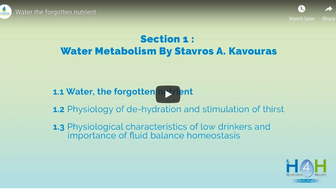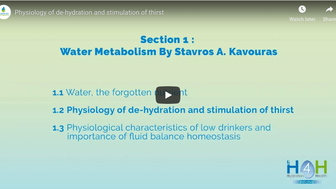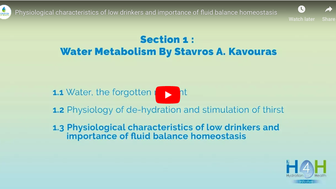Module 1: Water metabolism
Water has been described as a forgotten nutrient. Looking into the history of the dietary advices of USDA since 1947 water has not been included in the any of the nutritional advices including myPlate or different versions of the dietary pyramids. Interestingly even in nutrition conferences or scientific journals you rarely find any section related to water intake and health. Majority of what we know regarding water balance comes from dehydration, temperature regulation and exercise performance.
Total body water that account approximately 60% of body weight is distributed inside (intracellular) and out of cells (extracellular). Extracellular water is the water between cells called interstitial water and the water contained as part of the blood known as plasma water. Osmoreceptors and baroreceptor in circulation are primarily responsible for body water regulation by activating thirst and the fluid regulating hormones. Increase in osmolality activates the hormone vasopressin (also known as anti-diuretic) that decreased urinary output. What is interested is that this hormone gets activated well before thirst is activated.
People who consume low amount of water have higher levels of vasopressin which has been associated with many negative health outcomes, like diabetes and chronic kidney diseases. On the other side adequate water intake decreases vasopressin.
Learning objectives
- To understand why water is a nutrient, and why it has been described as the forgotten nutrient.
- To explain body water distribution and hormonal regulation
- To describe the hormonal profile of low water intake and how it impacts health
References
- Thornton SN. Thirst and hydration: physiology and consequences of dysfunction. Physiol Behav. 2010;100:15–21.
- Enhörning S, Wang TJ, Nilsson PM, Almgren P, Hedblad B, Berglund G, Struck J, Morgenthaler NG, Bergmann A, Lindholm E, et al. Plasma copeptin and the risk of diabetes mellitus. Circulation. 2010;121:2102–8.
- Clark WF, Devuyst O, Roussel R. The vasopressin system: new insights for patients with kidney diseases. J Intern Med. 2017;43:281–12.









